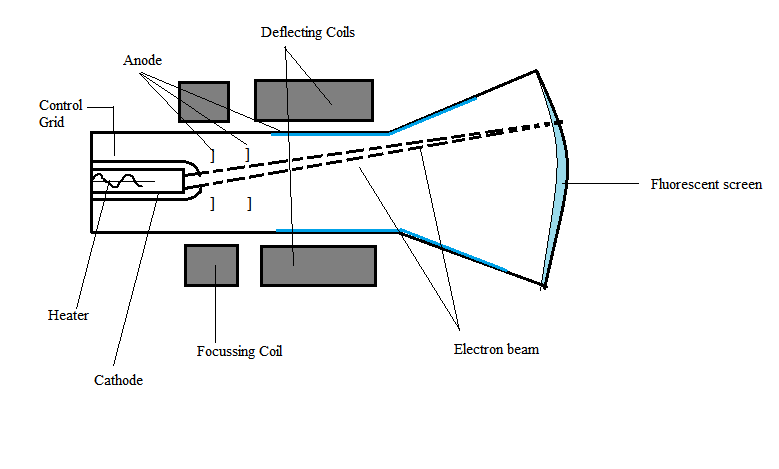
Draw a simplified labelled diagram of a hot cathode ray tube.
Answer
588.9k+ views
Hint: A hot cathode ray tube consists of a cathode, an anode, deflecting coils, a fluorescent screen, a heater, a focussing coil and a control grid. Students can imagine a hot cathode ray tube similar to that of the television tube, so that it becomes easy for them to know what components are present in the tube and how they are useful.
Complete step-by-step answer:
A cathode ray tube is a vacuum tube which consists of one or more electron guns and a phosphorescent screen so that it can display images on the screen. The cathode ray tube is constructed with the help of a glass envelope which is large and deep and is relatively fragile.
The images may represent electrical waveforms, pictures (television, computer monitors) , radar targets, or other phenomena. Cathode ray tubes also hold the record of being used as memory devices. The interior of the tube is kept evacuated, so as to facilitate the flow of free electrons from the electron guns to the tube’s face.
Cathode rays were first discovered by Julius Plücker , a German mathematician and Johann Wilhelm Hittorf. However the first cathode ray tube to use hot cathode was discovered by John Bertrand Johnson.
The diagram of a hot cathode ray tube is shown below:

Note: While drawing the diagram of the tube, students must be very careful with the labelling of the diagram, because even if a single element remains unlabelled, the diagram is considered to be incomplete. Students may also use arrow marks instead of straight lines to label the diagram.
Complete step-by-step answer:
A cathode ray tube is a vacuum tube which consists of one or more electron guns and a phosphorescent screen so that it can display images on the screen. The cathode ray tube is constructed with the help of a glass envelope which is large and deep and is relatively fragile.
The images may represent electrical waveforms, pictures (television, computer monitors) , radar targets, or other phenomena. Cathode ray tubes also hold the record of being used as memory devices. The interior of the tube is kept evacuated, so as to facilitate the flow of free electrons from the electron guns to the tube’s face.
Cathode rays were first discovered by Julius Plücker , a German mathematician and Johann Wilhelm Hittorf. However the first cathode ray tube to use hot cathode was discovered by John Bertrand Johnson.
The diagram of a hot cathode ray tube is shown below:

Note: While drawing the diagram of the tube, students must be very careful with the labelling of the diagram, because even if a single element remains unlabelled, the diagram is considered to be incomplete. Students may also use arrow marks instead of straight lines to label the diagram.
Recently Updated Pages
Master Class 12 Business Studies: Engaging Questions & Answers for Success

Master Class 12 Economics: Engaging Questions & Answers for Success

Master Class 12 English: Engaging Questions & Answers for Success

Master Class 12 Maths: Engaging Questions & Answers for Success

Master Class 12 Social Science: Engaging Questions & Answers for Success

Master Class 12 Chemistry: Engaging Questions & Answers for Success

Trending doubts
What are the major means of transport Explain each class 12 social science CBSE

Which are the Top 10 Largest Countries of the World?

Draw a labelled sketch of the human eye class 12 physics CBSE

Explain sex determination in humans with line diag class 12 biology CBSE

The pH of the pancreatic juice is A 64 B 86 C 120 D class 12 biology CBSE

Explain sex determination in humans with the help of class 12 biology CBSE




